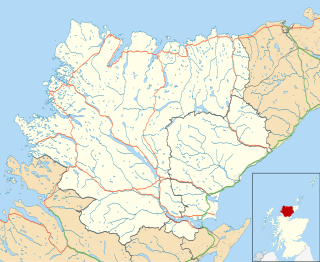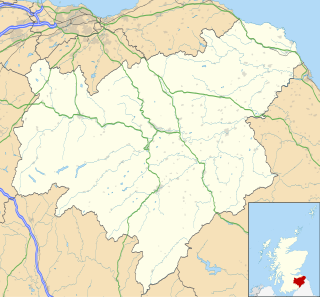
In the United Kingdom, a scheduled monument is a nationally important archaeological site or historic building, given protection against unauthorised change.

A listed building, or listed structure, is one that has been placed on one of the four statutory lists maintained by Historic England in England, Historic Environment Scotland in Scotland, Cadw in Wales, and the Northern Ireland Environment Agency in Northern Ireland.

Portsoy is a town in Aberdeenshire, Scotland.

Kinlochbervie is a scattered harbour village in the north west of Sutherland, in the Highland region of Scotland. It is the most northerly port on the west coast of Scotland.

Mingary Castle, also known as Mingarry Castle, is a castle situated a mile south-east of the small village of Kilchoan in Lochaber, Scotland. Nestled on ridge of rock overlooking the sea, it was considered a strategically important site in terms of communication with overseas areas and as an entranceway to the Sound of Mull. Mingary is roughly hexagonal in shape with nine-foot-thick walls, thicker on the seaward side. The remains of the castle are protected as a category A listed building.

Lochinver is a village on the coast in the Assynt district of Sutherland, Highland, Scotland. A few miles northeast is Loch Assynt which is the source of the River Inver which flows into Loch Inver at the village. There are 200 or so lochans in the area which makes the place very popular with anglers. Lochinver is dominated by the "sugar loaf" shape of Caisteal Liath, the summit peak of nearby Suilven.

Stromeferry is a village, located on the south shore of the west coast sea loch, Loch Carron, in western Ross-shire, Scottish Highlands and is in the Scottish council area of Highland. Its name reflects its former role as the location of one of the many coastal ferry services which existed prior to the expansion of the road network in the 20th century.

Drumbeg is a small village, townland and civil parish on the south bank of the River Lagan in County Down, Northern Ireland. The village is covered by the Lisburn City Council area and forms part of the suburban fringe of Belfast.

Duntrune Castle is located on the north side of Loch Crinan and across from the village of Crinan in Argyll, Scotland. It is thought to be the oldest continuously occupied castle on mainland Scotland. The castle is a category B listed building.
Canmore is an online database of information on over 320,000 archaeological sites, monuments, and buildings in Scotland. It was begun by the Royal Commission on the Ancient and Historical Monuments of Scotland. Historic Environment Scotland has maintained it since 2015. The Canmore database is part of the National Record of the Historic Environment, formerly the National Monuments Record of Scotland and contains around 1.3 million catalogue entries. It includes marine monuments and designated official wreck sites, such as the wreck of HMS Pheasant (1916).

Twynholm ( 'TWINE-um') is a village in Scotland. It is located 2 1⁄4 miles (3.6 km) north-northwest of Kirkcudbright and 4 1⁄2 miles (7.2 km) east of Gatehouse of Fleet on the main A75 trunk road. It is in the historic county of Kirkcudbrightshire, Dumfries and Galloway.

HMS Dartmouth was a small frigate or fifth-rate ship, one of six ordered by the English Council of State on 28 December 1654 and built in 1655.

HMS Campania was a seaplane tender and aircraft carrier, converted from an elderly ocean liner by the Royal Navy early in the First World War. After her conversion was completed in mid-1915 the ship spent her time conducting trials and exercises with the Grand Fleet. These revealed the need for a longer flight deck to allow larger aircraft to take off, and she was modified accordingly. Campania missed the Battle of Jutland in May 1916, but made a number of patrols with elements of the Grand Fleet. She never saw combat and was soon relegated to a training role because of her elderly machinery. In November 1918 Campania was anchored with the capital ships of the Grand Fleet when a sudden storm caused her anchor to drag. With no second anchor being laid, she hit several of the ships and the collisions punctured her hull; she slowly sank, with no loss of life. Her Officer of the Watch had failed to call the Captain, and was dismissed from the ship.

Minto is a village and parish in the Scottish Borders area of Scotland in Roxburghshire county. It is located 6 miles north-east of Hawick, north of the River Teviot.

Nedd is a small village, which lies on the western head of Loch Nedd in Lairg, western Sutherland, Scottish Highlands and is in the Scottish council area of Highland.

Culkein Drumbeg is a remote village on the north west coast of Scotland. It is located 0.93 miles (1.50 km) north west of Drumbeg in Assynt, Sutherland, in the Highland council area.

Many parts of Scotland are protected in accordance with a number of national and international designations because of their environmental, historical or cultural value. Protected areas can be divided according to the type of resource which each seeks to protect. NatureScot has various roles in the delivery of many environmental designations in Scotland, i.e. those aimed at protecting flora and fauna, scenic qualities and geological features. Historic Environment Scotland is responsible for designations that protect sites of historic and cultural importance. Some international designations, such as World Heritage Sites, can cover both categories of site.

This page gives an overview of the structure of environmental and cultural conservation in Scotland, a constituent country of the United Kingdom.

In Scotland, Marine Protected Areas (MPAs) are areas of sea defined so as to protect to habitats, wildlife, geology, undersea landforms, historic shipwrecks, and to demonstrate sustainable management of the sea. As of December 2018, approximately 22% of Scotland's seas were covered by the Scottish MPA network.

The Iona was Scottish-built paddle steamer, purchased by Confederate agents for use as a blockade runner during the American Civil War. Following a collision with Chanticleer she sunk in the Upper Clyde near Fort Matilda in October 1862. The wreck, which lies around 27 m below chart datum, is now designated as a Historic Marine Protected Area by Historic Environment Scotland.



















